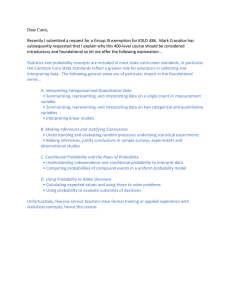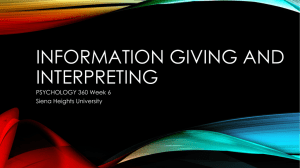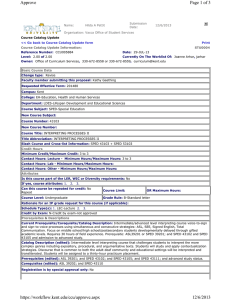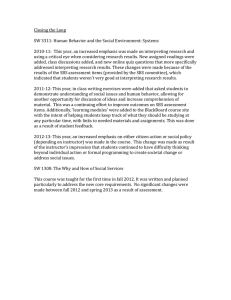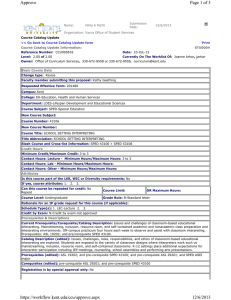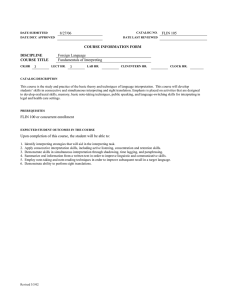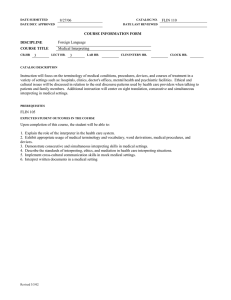of Submission Name:
advertisement
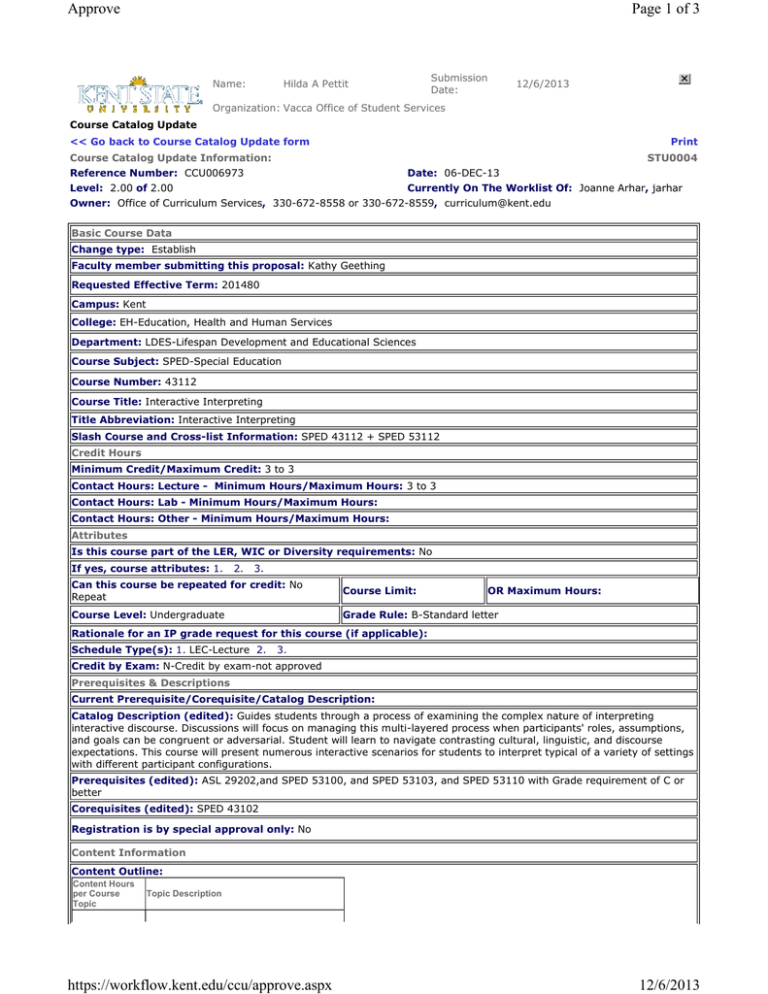
Approve Page 1 of 3 Name: Submission Date: Hilda A Pettit 12/6/2013 Organization: Vacca Office of Student Services Course Catalog Update << Go back to Course Catalog Update form Print Course Catalog Update Information: STU0004 Reference Number: CCU006973 Date: 06-DEC-13 Level: 2.00 of 2.00 Currently On The Worklist Of: Joanne Arhar, jarhar Owner: Office of Curriculum Services, 330-672-8558 or 330-672-8559, curriculum@kent.edu Basic Course Data Change type: Establish Faculty member submitting this proposal: Kathy Geething Requested Effective Term: 201480 Campus: Kent College: EH-Education, Health and Human Services Department: LDES-Lifespan Development and Educational Sciences Course Subject: SPED-Special Education Course Number: 43112 Course Title: Interactive Interpreting Title Abbreviation: Interactive Interpreting Slash Course and Cross-list Information: SPED 43112 + SPED 53112 Credit Hours Minimum Credit/Maximum Credit: 3 to 3 Contact Hours: Lecture - Minimum Hours/Maximum Hours: 3 to 3 Contact Hours: Lab - Minimum Hours/Maximum Hours: Contact Hours: Other - Minimum Hours/Maximum Hours: Attributes Is this course part of the LER, WIC or Diversity requirements: No If yes, course attributes: 1. 2. 3. Can this course be repeated for credit: No Repeat Course Limit: Course Level: Undergraduate Grade Rule: B-Standard letter OR Maximum Hours: Rationale for an IP grade request for this course (if applicable): Schedule Type(s): 1. LEC-Lecture 2. 3. Credit by Exam: N-Credit by exam-not approved Prerequisites & Descriptions Current Prerequisite/Corequisite/Catalog Description: Catalog Description (edited): Guides students through a process of examining the complex nature of interpreting interactive discourse. Discussions will focus on managing this multi-layered process when participants' roles, assumptions, and goals can be congruent or adversarial. Student will learn to navigate contrasting cultural, linguistic, and discourse expectations. This course will present numerous interactive scenarios for students to interpret typical of a variety of settings with different participant configurations. Prerequisites (edited): ASL 29202,and SPED 53100, and SPED 53103, and SPED 53110 with Grade requirement of C or better Corequisites (edited): SPED 43102 Registration is by special approval only: No Content Information Content Outline: Content Hours per Course Topic Topic Description https://workflow.kent.edu/ccu/approve.aspx 12/6/2013 Approve 3 3 3 3 9 9 6 9 Page 2 of 3 The Process of Interacting: Examining cultural norms, communication goals, participant bias, and contextual cues that impact a communication interaction. Discuss how these inform and affect an interpretation. The Process of Interacting: Identify and discuss the componenets of register and how setting and communicative competence affect register. Model of Interpreing: Examine the professional model of an interpreted interaction. Discuss the implications of divergent goals, implicit & explicit intent, and environmental factors. Practice managing the multi-layered process. Communication Conflicts: Explore issues of turn-taking, gender language differences, politeness strategies, and indirectness and ambiguity. Informal Scenarios: Interpreting practice and analysis of informal communication settings such as collaborative interactions, class discussions, and heated exchanges. Consultative Scenarios: Interpreting practice and analysis of these settings such as medical consultations, social service intakes, school disciplinary sessions, police interrogations. Formal Scenarios: Interpreting practice and analysis of an extended presentation with opportunities for team interpreting in a variety of configurations. Final Project: Groups of students prepare a final interactive scenario that incorporates class members as impromptu participants and where all members of the group must function in the role of the interpreter. Display/Hide Delimited Course Outline Total Contact Hours: 45 Textbook(s) used in this course: Interactive Interpreting: Let's Talk From Topic Boundaries to Omission: New Research on Interpreting Writing Expectations: Students will analyze discourse and create diagnostic assessments of interpretations. Written responses to selected research studies. Grad-level course requires written examination of team interpreting and presentation to the class. Instructor(s) expected to teach: SPED Faculty Instructor(s) contributing to content: Pam Luft Proposal Summary Explain the purpose for this proposal: The SPED program is creating a new slash course to fit the needs of the ASL English Interpreting concentration. The content of this course is not incorporated in to any current courses as the skill set required for interactive interpreting is unique. Professional research, expectations of the national certification exam, feedback from our practicum supervisors, and the changing venues and dynamics of interpreting work have guided the creation of this course. The overall goal of this course is to prepare students to accurately and effectively manage the multi-layered interpretation process fo bi-lingual, bi-cultural, and bi-modal interactive communication events. Interpreting distributed conversation is immensely more difficult than interpreting monologues due to time constraints, rapid-turn-taking, and differing conversational norms. Students will apply a variety of learning strategies in and out of class to examine the complex dynamics of interactive communication with these examinations ultimately leading to the actual interpretation of interactive contexts across registers and settings. The course will incorporate 1) classroom discussions regarding ethical and practical demand of various registers, settings, and number of participants, 2) documented interviews with interpreters, 3) written analysis of interactive communication events, 4) real-time interpreting and the analysis of these interpretations to enable students to build knowledge and gain https://workflow.kent.edu/ccu/approve.aspx 12/6/2013 Approve Page 3 of 3 skill proficiencies. Through these strategies students will be able to: 1) Recognize the communicative goals and the cultural expectations of the communication participants and describe how these goals affect the interpretation. These goals may be unspoken and unknown to the other participants, but the goals influence vocabulary choices, sentence construction, and any number of paralinguistic features. 2) Propose and implement strategies for accurately rendering implicit and explicit messages recognizing that each culture places opposing values on these types of messages. 3) Identify and demonstrate approaches for migating cultural and communication conflicts that interfere with the flow of the interaction and may distort the intended meaning and develop an awareness of the communication rhythm, which can signal underlying agendas for power and control or relationship building. 4) Describe cultural perspectives and apply techniques for handling overlaps, interruptions, turn-taking, and politeness. 5) Produce interpretations appropriate for a variety of registers and settings. 6) Apply techniques for interpreting as a member of a team. A growing workplace demand is having more than one interpreter handling the discourse of a single event. This is done for reasons of ergonomic safety as well as shared responsibility for intense processing demands. A teaming situation carries with it all the expectations of facilitating cross-cultural communication with the additional requirement of making two interpreters' processing and production syltes mesh to create one seamless interpretation. Interactive interpreting presents many unique and complex challenges for the interpreter. With the increased emphasis on achieving national certification and with certification tests heavily incorporating interactive exchanges, this course offers essential training for interpreting students. Explain how this proposal affects program requirements and students in your unit: This course is currently being offered as a special topics course. This proposal is for interactive interpreting to become a required course for all interpreting majors. This would expand the curriculum to include critical skill and professional development not addressed in current courses. The required program hours will not change since ITEC 19525 is being removed from the program. Explain how this proposal affects courses, program requirements and student in other units: This course would be for interpreting majors only and should have no impact on other programs or students. Explain how this proposal affects enrollment and staffing: The College Dean has approved hiring a new faculty member to support the ASEI program. With the hiring of this full-time NTT instructor, no additional faculty will be needed. Units consulted (other departments, programs or campuses affected by the proposal): The basic premise and rationale for this course were discussed with Dr. Pam Luft, Professor: Deaf Education and Dr. Mary Dellmann-Jenkins, Director: Lifespan Development & Educational Sciences. Comments (500 Character Maximum): NOTE: Please do not use the following restricted characters: (~ * / \ --) Approve Comments: Date 12/6/2013 Return To Initiator User Susan M Augustine Return To Prior Approver Deny Comment No comments available. History: Date User Status 12/6/2013 Mary M. Dellmann-Jenkins Approved 12/6/2013 Susan M Augustine Submitted https://workflow.kent.edu/ccu/approve.aspx 12/6/2013

